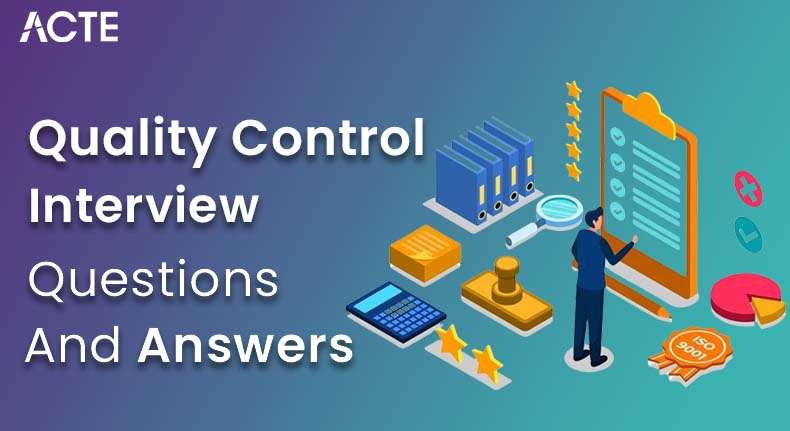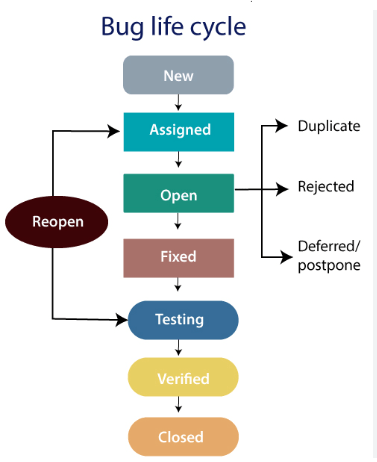
Quality control is essential for ensuring products or services adhere to predetermined standards and customer demands. It encompasses activities like inspections, tests, and audits to detect and rectify any deviations from quality criteria. By ensuring consistency and reliability in production processes, quality control enhances customer satisfaction and brand reputation. It plays a pivotal role in guaranteeing product safety, reliability, and adherence to regulatory requirements.
1. Explain Quality Control (QC)
Ans:
Quality Control ensures products meet standards by employing inspection, testing, or other measures to identify defects. It’s a reactive process that comes into play after production, aiming to rectify issues and maintain consistency in the end product. Through QC, organizations strive to enhance customer satisfaction, build trust, and uphold their reputation for delivering reliable products.
2. What is a good test case?
Ans:
A good test case is not only comprehensive but also focused, targeting specific functionalities or scenarios within the software. It should be easily reproducible and understandable, facilitating efficient debugging and issue resolution. Additionally, a good test case considers various inputs, boundary conditions, and error-handling scenarios to ensure thorough coverage of the software’s behavior.
3. What does a quality control specialist do?
Ans:
- Quality control specialists play a pivotal role in ensuring products meet established quality standards.
- They conduct thorough inspections and tests, meticulously examining products for defects or deviations from specifications.
- Specialists collaborate with cross-functional teams to implement corrective actions, monitor processes to maintain consistency, and continuously seek opportunities to enhance product quality and reliability.
4. How are software bugs minimized?
Ans:
Software bugs are minimized through a combination of proactive measures and rigorous testing methodologies. This includes adopting coding best practices, such as code reviews and automated testing, to identify and rectify issues early in the development cycle. Continuous integration and deployment practices help catch bugs sooner, while robust bug-tracking systems facilitate efficient resolution and mitigation of identified issues.

5. What are the benefits and drawbacks of quality control for software?
Ans:
Software quality control offers numerous advantages, including improved product reliability, heightened customer satisfaction, and reduced risks of costly errors or failures. However, it also comes with certain drawbacks, such as increased time and cost associated with thorough testing processes, potential delays in product release due to stringent quality checks, and the Risk of stifling innovation if too much emphasis is placed on conformity.
6. Which abilities or characteristics are essential to the effectiveness of quality control?
Ans:
Successful quality control relies on a combination of technical expertise and soft skills. Attention to detail is essential for thorough inspection and detection of defects, while analytical thinking helps identify root causes and implement effective corrective actions. Effective communication and collaboration skills facilitate seamless interaction with cross-functional teams, while adaptability and continuous learning enable adaptation to evolving standards and technologies.
7. What objects do you include in your test cases?
Ans:
- Test cases encompass various elements, including inputs, expected outcomes, boundary conditions, and edge cases, to ensure comprehensive coverage of the software’s functionality.
- Additionally, test cases incorporate data variations, user interactions, and integration points to replicate real-world usage scenarios and identify potential issues.
- Error handling scenarios are also included to assess the software’s robustness and resilience in the face of unexpected situations.
8. What exactly does “branch testing” entail?
Ans:
- Branch testing is a testing technique that focuses on exercising different decision paths or branches within the software code.
- It involves testing each possible branch or decision point independently to ensure that all code paths are executed and tested thoroughly.
- By verifying outcomes for both true and false conditions, branch testing helps maximize code coverage and identify potential issues in decision-making logic, thereby enhancing the software’s overall reliability and robustness.
9. What are the differences between process and product quality?
Ans:
| Aspect | Process Quality | Product Quality |
|---|---|---|
| Focus | Methods and procedures used in production or service delivery | Characteristics and attributes of the end result |
| Measurement | Adherence to standards, efficiency, effectiveness | Conformance to specifications, customer satisfaction |
| Control | Process improvement methodologies (Six Sigma, Lean, TQM). | Quality assurance techniques (testing, inspections, audits) |
| Impact | Inconsistent results, inefficiencies, higher costs | Customer dissatisfaction, returns, warranty claims |
10. Describe bug release and bug leakage.
Ans:
Bug release occurs when a software defect goes undetected during testing and is deployed to users, potentially causing harm or inconvenience. Despite efforts to identify and resolve bugs before release, some defects may slip through the cracks, leading to user-reported issues or negative feedback. Bug leakage, on the other hand, refers to undetected defects in a released version of the software that manifest later, often after deployment.
11. What kinds of tests are conducted as part of the quality control process?
Ans:
- Quality control encompasses a variety of tests, such as unit testing for individual components.
- System testing validates adherence to system requirements.
- Acceptance testing aligns with user needs.
- Regression testing confirms the absence of new issues.
- Performance testing assesses system speed and efficiency.
12. What parameters constitute a standard quality control?
Ans:
Standard quality control measures embrace reliability, functionality, and usability. They encompass factors like performance, efficiency, and maintainability. Additionally, standards address security, scalability, and compatibility. Compliance with industry norms and regulations is pivotal. Thorough documentation and traceability are indispensable. Continuous improvement and feedback mechanisms are integral components.
13. What role do standards play in quality control?
Ans:
- Standards act as benchmarks for assessing quality.
- They ensure consistency and reliability across processes.
- Facilitate interoperability and compatibility among systems.
- Aid in compliance with regulatory standards and requirements.
- Standards provide guidelines for optimal practices and processes.
- They instill trust and confidence in products or services.
14. What is boundary testing?
Ans:
Boundary testing examines input extremes by assessing the upper and lower limits of input values. It helps understand system behavior near these thresholds and identifies potential errors or vulnerabilities. This type of testing strengthens software robustness and reliability. For example, it involves testing a system with both maximum and minimum input values. Effective boundary testing improves overall software quality and stability.
15. What kind of quality control parameters are available for software quality control?
Ans:
- Software quality control parameters encompass functional correctness.
- Essential aspects include performance efficiency, usability, and reliability.
- Additionally, security, compatibility, and compliance are pivotal.
- Adequate documentation and traceability standards are imperative.
- Essential continuous improvement processes and feedback mechanisms ensure quality.
- These parameters collectively uphold software quality.
16. What is the software testing life cycle?
Ans:
The software testing life cycle begins with test planning and analysis, followed by test design and implementation. It then moves on to test execution and bug tracking. Evaluation and test reporting are integral phases. The cycle concludes with test completion and review, ensuring thorough testing and quality assurance. Continuous feedback is incorporated throughout to refine the process and improve outcomes. This structured approach helps in identifying and addressing issues early.
17. Explain the different test levels and give examples.
Ans:
- Unit Testing: Tests individual units/components in isolation, e.g., testing a function.
- Integration Testing: Tests interactions between units, ensuring they work together, e.g., testing module integration.
- System Testing: Tests the entire system as a whole, e.g., testing the complete software application.
- Acceptance Testing: Validates if the system meets business requirements, e.g., user acceptance testing.
18. What is exploratory testing?
Ans:
Exploratory testing is an informal approach to software testing. Testers explore the software’s functionality without predefined test cases. It relies on testers’ experience and intuition to uncover defects. Testers learn about the system while testing, adapting their approach dynamically. Exploratory testing is effective in finding unexpected defects and can be used in conjunction with other testing methods.
19. Explain stress testing, load testing, and volume testing.
Ans:
- Stress testing assesses system stability under extreme conditions, e.g., testing beyond normal operational limits.
- Load testing checks system behavior under anticipated loads, e.g., testing concurrent user interactions.
- Volume testing evaluates system performance with large data volumes, e.g., testing database scalability.
- Each test targets different aspects of system performance.
- Stress tests ensure reliability under pressure, load tests gauge performance under expected loads, and volume tests assess scalability with large data.
20. What is performance testing?
Ans:
Performance testing aims to assess system speed and responsiveness, scalability, and stability under varied loads. It is essential to identify performance bottlenecks and areas for improvement. Performance testing encompasses load testing, stress testing, and volume testing. The goal is to ensure optimal system performance across diverse conditions, such as examining website response times during peak traffic periods.
21. What are the primary objectives of quality assurance in software development?
Ans:
- Ensure adherence to specified requirements.
- Identify and rectify defects in early development stages.
- Enhance customer satisfaction and trust in the software.
- Maintain consistent and reliable software performance.
- Improve overall efficiency in the software development process.
- Facilitate continuous learning and improvement within the development team.
22. Explain “defect density” in software quality control.
Ans:
- Defect density measures defects per unit size, often lines of code.
- It gauges software quality relative to its size.
- High defect density signals potential issues in the code.
- It is calculated by dividing defects by the unit size.
- Tracking defect density aids in prioritizing necessary fixes.
- Provides valuable insights for ongoing process enhancement.
23. How does regression testing contribute to software quality?
Ans:
Ensures that existing functionalities remain unaffected by changes.Detects unintended side effects of modifications or updates.Prevents regression bugs from reaching production environments.Enhances confidence in the software’s overall stability.Saves time and resources by identifying issues early in development.Supports the maintenance of software integrity over time.
24. What is the role of documentation in quality control?
Ans:
Documentation serves as a reference for understanding project requirements, facilitates clear communication among team members, aids in reproducing and troubleshooting issues efficiently, acts as a guide for future maintenance and updates, enhances transparency and accountability within the development process, and ensures continuity and consistency in software development practices.
25. How do automated testing tools improve efficiency in quality control?
Ans:
- Automate repetitive testing tasks for increased efficiency.
- Expand test coverage and enhance accuracy.
- Accelerate the overall testing process.
- Provide consistent and repeatable testing results.
- Improve the overall effectiveness of the testing process.
26. Explain “code review” in quality control.
Ans:
Code review involves a collaborative examination of code for defects and improvements. It ensures adherence to coding standards and overall code quality. It facilitates knowledge sharing and continuous learning within the team. It contributes to the overall reliability and maintainability of the software. It strengthens team collaboration and collective code ownership.
27. How do you prioritize software defects for resolution?
Ans:
Assess the impact on users and critical functionalities. Consider the severity and potential risks associated with each defect. Prioritize based on customer feedback and business needs. Evaluate available resources and timelines for fixing defects. Employ prioritization techniques like MoSCoW (Must, Should, Could, Won’t). Continuously reassess and adjust priorities to meet evolving requirements.
28. What are some strategies for maintaining consistent quality standards across teams?
Ans:
- Establish clear quality guidelines and standards for all teams.
- Provide training and resources to ensure team members are aligned.
- Encourage collaboration and knowledge sharing among teams.
- Implement regular reviews and audits to maintain standards.
- Foster a culture of accountability and continuous improvement.
- Utilize tools and automation to ensure consistency and efficiency across teams.
29. What are the common challenges in implementing quality control?
Ans:
- Resistance to change within teams may hinder implementation.
- Limited resources and budget constraints can pose challenges.
- Balancing quality with time-to-market pressures is often difficult.
- Ensuring buy-in and participation from all stakeholders can be challenging.
- Maintaining consistency across distributed teams can be a struggle.
- Addressing the overhead of documentation and processes is a common challenge.
30. What is the relationship between continuous integration and quality control?
Ans:
Continuous integration (CI) ensures frequent integration of code changes.CI pipelines include automated testing to validate code changes. CI processes facilitate the early detection of defects. CI promotes a culture of quality by providing rapid feedback to developers. It improves overall software stability and reliability. CI seamlessly integrates quality control into the development workflow.
31. What is the importance of user acceptance testing (UAT) in software quality?
Ans:
- UAT ensures software meets user expectations before deployment.
- Identifies potential issues missed during development and testing.
- Validates user experience, functionality, and usability.
- Enhances customer satisfaction and confidence in the product.
- Reduces post-deployment defects and associated costs.
- Critical for ensuring software quality aligns with business objectives.
32. How do we measure the effectiveness of quality control?
Ans:
To maintain consistent quality standards across teams, monitor defect rates and resolution times, assess customer satisfaction and feedback, and measure adherence to quality standards and specifications. Additionally, analyze process and workflow efficiency, conduct regular quality audits and reviews, and track productivity and cost savings improvements. Implement continuous training and development programs and foster open communication to address quality issues promptly.
33. What is the role of risk management in quality control?
Ans:
- Identifies potential threats to quality early in the process.
- It helps prioritize resources and efforts based on risk severity.
- Mitigates uncertainties that could affect product quality.
- Enhances decision-making by considering risk implications.
- Minimizes the likelihood of quality-related setbacks.
- Ensures a proactive approach to maintaining quality standards.
34. What is the significance of “code coverage” in quality control?
Ans:
- Measures the extent of code tested by test cases.
- Provides insight into areas lacking test coverage.
- It helps identify potential defects and vulnerabilities.
- Ensures comprehensive testing of the software.
- Improves the reliability and robustness of the code.
- Facilitates a more accurate assessment of software quality.
35. How does the traceability matrix aid in quality control?
Ans:
To maintain consistent quality standards, it is crucial to link requirements to test cases and vice versa, ensuring comprehensive coverage. Tracking requirement coverage through testing verifies that all requirements are adequately addressed. Facilitating impact analysis of changes throughout development helps manage potential effects effectively. Enhancing transparency and accountability in testing improves visibility and responsibility while streamlining the traceability of defects to their sources, which ensures efficient issue resolution.
36. What are the key components of a test plan?
Ans:
- Objectives and scope of testing.
- Test strategies and methodologies.
- Test environment and resources needed.
- Test case specifications and execution procedures.
- Defect tracking and reporting mechanisms.
- Roles and responsibilities of testing team members.
37. How do defect-tracking systems enhance quality control?
Ans:
To maintain consistent quality standards across teams, centralize and prioritize defect management. Ensure visibility into defect status to keep all teams informed. Facilitate collaboration between development and testing teams to address issues effectively. Identify recurring problems for root cause analysis to prevent future defects. Enhance communication regarding defect resolution and enable continuous improvement in software quality.
38. What is the role of configuration management in quality control?
Ans:
- Manages changes to software and documentation.
- Ensures consistency and integrity across different versions.
- Facilitates tracking of configurations and their relationships.
- Controls access to configuration items to prevent unauthorized changes.
- It helps in reproducing and diagnosing defects accurately.
- Enhances the stability and reliability of the software.
39. What is the importance of stakeholder involvement in quality control?
Ans:
- Provides valuable insights into user expectations.
- Ensures alignment of quality goals with business objectives.
- Facilitates early identification of requirements and risks.
- Enhances transparency and accountability in the quality process.
- Improves acceptance and adoption of the final product.
- Fosters a collaborative approach to achieving quality standards.
40. How does continuous improvement enhance quality control?
Ans:
- Encourages ongoing refinement of processes and practices.
- Identifies and addresses areas for enhancement proactively.
- Promotes a culture of learning and innovation.
- Improves efficiency and effectiveness in quality control.
- Responds promptly to changes in technology and market demands.
41. Why is quality control vital for customer satisfaction?
Ans:
A cornerstone of quality control is ensuring products align with customer expectations. Quality control actively reduces defects, maintaining a consistent level of performance. Trust and loyalty among customers are nurtured through reliable product delivery. By minimizing returns and complaints, satisfaction is naturally enhanced. Quality control reinforces brand reputation, fostering repeat business opportunities.
42. How does early quality control affect software development?
Ans:
- Detecting defects at their inception significantly shapes the software development process.
- The subsequent reduction in costs and efforts to rectify issues later is substantial.
- Overall efficiency experiences a marked improvement through early quality control measures.
- Within the development team, a culture steeped in quality is cultivated.
- The timely detection of defects prevents their escalation into larger, more complex problems.
43. What is “shift-left testing” and its relevance to quality control?
Ans:
“Shift-left testing” signifies a strategic move of testing activities earlier in the development phases. Emphasizing testing during requirements and design stages results in profound benefits. Timely defect detection reduces rework and associated costs. The approach ensures that quality becomes an integral part of the product from inception. Software quality and reliability witness notable improvements with shift-left testing.
44. How do metrics and KPIs measure quality control effectiveness?
Ans:
- Metrics and KPIs furnish tangible measures to gauge the efficacy of quality control efforts.
- They meticulously track defect rates, customer satisfaction levels, and other pertinent indicators.
- Trend analysis over time facilitates the assessment of process enhancements.
- By pinpointing areas necessitating focus and resource allocation, they provide invaluable insights.
- These data-driven tools pave the way for informed decision-making processes.
45. Why is usability testing important in software quality?
Ans:
Usability testing serves as a critical evaluation of user interaction with software. Identifying user experience challenges and incorporating feedback bolsters product design. The resultant enhancement in user satisfaction and adoption rates is significant. Preempting user confusion through usability testing effectively reduces support costs. Ultimately, it propels the development of more competitive and successful software products.
46. How do you balance time constraints with maintaining quality standards?
Ans:
Task prioritization based on quality impact is pivotal in navigating time constraints. Utilizing risk-based approaches channels efforts toward critical areas. Automation of repetitive tasks optimizes time usage without compromising quality. Clear quality objectives aid in resource allocation for optimum efficiency.Emphasizing communication and collaboration streamlines processes within time constraints.
47. What strategies prevent defects during requirements gathering?
Ans:
- Early involvement of stakeholders and end-users lays a robust foundation for defect mitigation.
- Techniques such as prototyping and user stories clarify requirements and preempt defects.
- Rigorous reviews and validations of requirements documents are imperative.
- Open communication fosters the resolution of ambiguities and misunderstandings.
- Leveraging experienced analysts anticipates and mitigates potential issues effectively.
48. Explain “root cause analysis” in quality control.
Ans:
“Root cause analysis” delves into uncovering the fundamental reasons underlying problems. Its scope extends beyond symptom treatment to addressing core issues. Techniques like the “5 Whys” method delve deep into uncovering causal factors. Understanding root causes facilitates the implementation of preventive actions. It nurtures a culture of continuous improvement and learning within quality control.
49. How does quality control ensure regulatory compliance?
Ans:
- Quality control processes are meticulously aligned with regulatory standards and requirements.
- Rigorous documentation and traceability mechanisms ensure compliance.
- Regular audits serve as checkpoints, verifying adherence to established quality standards.
- Continuous monitoring promptly identifies deviations, triggering corrective actions.
- Ensuring products meet safety and quality regulations is paramount within quality control.
50. How do agile methodologies impact quality control?
Ans:
Agile methodologies underscore iterative development and feedback loops. Continuous integration and testing protocols ensure the early detection of defects. Close collaboration among agile teams facilitates addressing quality concerns throughout the process. Quality is inherently ingrained into the development process rather than treated as an afterthought. Agile’s adaptive nature enables swift responses to evolving requirements or defects.
51. What are the pros and cons of outsourcing quality control?
Ans:
- Pros: Cost savings, access to specialized expertise, scalability, focus on core activities, potential for increased efficiency that can streamline operations, and global reach.
- The cons are communication challenges, loss of control, quality inconsistencies, dependency on third-party providers, potential security risks, and cultural differences.
52. How does quality control ensure software security?
Ans:
Quality control ensures software security through rigorous testing for vulnerabilities, adherence to security standards, code reviews, and encryption techniques. It involves identifying and fixing security flaws, implementing access controls, and regularly updating software to patch security vulnerabilities. Quality control also involves security audits, threat modeling, and risk assessments to mitigate potential security risks.
53. How does knowledge transfer maintain quality control standards?
Ans:
- Knowledge transfer ensures continuity in quality control standards by sharing best practices, lessons learned, and expertise among team members.
- It helps in disseminating updated procedures, techniques, and tools for effective quality control.
- Through knowledge transfer, experienced personnel pass on their insights to new team members, fostering a culture of continuous improvement.
54. Why balance manual and automated testing in quality control?
Ans:
Manual testing allows for exploratory testing, user experience evaluation, and testing scenarios that are difficult to automate. Automated testing enhances the efficiency, repeatability, and coverage of test cases, especially for regression testing and large-scale projects. Balancing both ensures comprehensive testing coverage, leveraging the strengths of each approach while compensating for their respective limitations.
55. How does risk assessment determine quality control scope?
Ans:
Risk assessment identifies potential threats to project success, including quality-related risks. It helps prioritize quality control efforts by focusing on areas with a higher risk of failure or impact. By evaluating factors such as complexity and criticality, the scope of quality control is tailored to address the most significant risks first. This approach ensures that resources are allocated effectively and the most critical issues are promptly addressed.
56. What’s the difference between defect prevention and detection?
Ans:
- Defect prevention aims to eliminate errors at the source through process improvements, training, and proactive measures.
- Defect detection involves identifying and correcting errors after they have occurred, typically through testing and inspections.
- Prevention focuses on stopping defects from entering the system, while detection deals with finding and fixing defects already present.
57. How do past project lessons improve quality control?
Ans:
Past project lessons provide valuable insights into what worked well and what didn’t in terms of quality control practices. They enable teams to learn from mistakes, refine processes, and avoid repeating errors. By analyzing past experiences, teams can implement preventive actions and optimizations, enhancing overall quality control effectiveness.
58. What is the role of code refactoring in improving software quality?
Ans:
- Code refactoring improves software quality by restructuring code to enhance readability, maintainability, and extensibility.
- It eliminates redundancy, simplifies complex code, and improves code maintainability, leading to fewer defects and easier debugging.
- Refactoring also supports software evolution by facilitating the addition of new features and accommodating changing requirements without introducing bugs.
59. Explain “technical debt” and its impact on quality control.
Ans:
Technical debt refers to the cumulative consequences of taking shortcuts or compromising quality in software development. It leads to increased complexity, reduced maintainability, and higher chances of defects in the long run. Technical debt impacts quality control by slowing down development, increasing the risk of bugs, and hindering software evolution.
60. Why is continuous monitoring crucial in quality control?
Ans:
Continuous monitoring allows for real-time detection of deviations from quality standards, enabling prompt corrective action. It ensures that quality objectives are consistently met throughout the software development lifecycle. By monitoring metrics, performance, and customer feedback, continuous monitoring facilitates proactive quality improvement and risk mitigation.
61. How important are clear quality control standards for teams?
Ans:
- Establishing clear standards ensures consistency,
- Product quality and customer satisfaction.
- Teams comprehend expectations, reducing errors,
- We are enhancing efficiency and fostering accountability.
- Alignment with goals and improvement initiatives,
- Drives continuous improvement in processes.
62. What is the significance of peer reviews in quality control?
Ans:
- Peer reviews provide fresh perspectives,
- Spotting errors and enhancing quality early.
- Collaboration improves team communication,
- Identifying errors early reduces rework,
- You are elevating overall product quality and reliability.
63. How do you adapt quality control to changing project requirements?
Ans:
Flexibility in methodologies adjusts to new demands, ensuring processes remain relevant. Continuous evaluation and adaptation maintain alignment with project objectives and goals. Agile approaches enable swift adjustments and uphold quality despite evolving requirements. This adaptability helps teams stay responsive and effective. Regular feedback loops further enhance improvement.
64. What is the role of test environments in quality control?
Ans:
- Test environments replicate production settings,
- We are ensuring realistic product quality assessments.
- Isolated environments prevent interference,
- They are allowing thorough testing without user impact.
- Early issue identification before deployment,
- Elevates overall reliability and customer satisfaction.
65. What are the strategies for fostering a quality culture in development?
Ans:
- Advocating a mindset valuing quality,
- It highlights its significance across the organization.
- Training on quality practices and education,
- Encourages ownership and accountability at all levels.
- Recognizing quality achievements and improvements,
- Cultivates a culture of continuous enhancement.
66. How does risk-based testing optimize quality control?
Ans:
Prioritizing tests by potential impact ensures efficient use of resources and reduces overall risk by focusing on critical areas. Early identification and mitigation of high-risk issues are crucial for minimizing defects. Balancing thoroughness with efficiency enhances overall test effectiveness. This approach improves product quality and streamlines testing, leading to greater customer satisfaction.
67. What is the impact of globalization on software quality control?
Ans:
Globalization introduces diverse user requirements, increasing complexity, and quality control challenges. Cultural differences can impact usability and acceptance, requiring comprehensive testing across various contexts. Collaborative tools help distributed teams by facilitating effective communication and coordination. These tools ensure that quality standards are consistently met despite geographical and cultural differences.
68. How is quality control aligned with project goals and objectives?
Ans:
- Integrating quality control into project planning,
- Ensures alignment with objectives and expectations.
- Clear communication of quality goals to stakeholders,
- Promotes shared understanding and commitment.
- Metrics tracking progress towards quality objectives,
- Guides decision-making and process improvements.
69. What is the role of leadership in promoting a quality culture?
Ans:
- Leadership sets the tone for quality,
- It emphasizes its importance through actions and words.
- Providing resources and support for quality initiatives,
- You are demonstrating a commitment to continuous improvement.
- We are empowering teams to prioritize quality in all endeavors.
70. What is “continuous validation,” and what is its importance?
Ans:
Continuous validation involves ongoing assessment to ensure products meet quality standards throughout development. Regular feedback loops enable quick adjustments, address issues promptly, and minimize rework. This approach enhances agility and responsiveness to change. It supports iterative development, fosters continuous improvement, and ensures alignment with evolving requirements.
71. What are the challenges in ensuring compatibility and interoperability?
Ans:
Compatibility and interoperability pose challenges due to diverse systems and platforms. Ensuring seamless communication between different technologies is complex. Updates or changes in one system may disrupt compatibility with others. Testing across various environments is essential but resource-intensive. Standardization efforts help, but discrepancies still arise. Constant vigilance and adaptation are necessary to maintain compatibility.
72. How are dependencies managed in quality control?
Ans:
Identifying and tracking dependencies is critical for effective quality control. Dependency management involves understanding how changes affect interconnected components. Establishing clear protocols for handling dependencies minimizes risks. Regular updates and communication among teams are essential to manage dependencies. Automated tools can aid in dependency analysis and resolution.
73. What is the role of traceability, and what are its benefits?
Ans:
- Traceability ensures a clear understanding of the development process from start to finish.
- It facilitates identifying the origin of issues and tracking changes throughout the lifecycle.
- Enhances accountability by linking requirements to specific actions or decisions.
- Helps in compliance with regulatory standards and auditing requirements.
- Enables effective risk management and change control.
- Ultimately, traceability promotes transparency and confidence in the product.
74. What is the importance of a robust testing infrastructure?
Ans:
- A robust testing infrastructure ensures a thorough evaluation of software functionality.
- It supports various testing types, including unit, integration, and performance testing.
- Scalability and Flexibility are essential for accommodating evolving project needs.
- Automation capabilities streamline repetitive tasks, improving efficiency.
- Comprehensive test coverage reduces the likelihood of undiscovered defects.
- Ultimately, a solid testing infrastructure bolsters overall product quality and reliability.
75. How do test automation frameworks streamline quality control?
Ans:
Test automation frameworks automate repetitive testing tasks. They ensure consistent test execution, minimizing human error. Frameworks allow for the creation of reusable test scripts, saving time and effort. Automated tests can be run across different environments rapidly. Test results are generated quickly, facilitating prompt issue resolution. Overall, test automation enhances efficiency and test coverage in quality control.
76. What is the “zero-defect mindset”?
Ans:
The zero-defect mindset emphasizes preventing defects rather than fixing them later. It instills a culture of continuous improvement and quality consciousness. Teams aim for perfection in every stage of development and testing. Proactive measures such as code reviews and automated testing are prioritized. Embracing the mindset fosters higher quality standards and customer satisfaction.
77. How are quality challenges addressed in agile development?
Ans:
Agile development emphasizes iterative, incremental delivery. Continuous testing and feedback loops are integral to maintaining quality. Collaborative teamwork ensures a shared responsibility for quality throughout the process. Agile frameworks provide Flexibility in adapting to changing requirements and priorities. Close collaboration with stakeholders ensures alignment with expectations.
78. What is the role of customer feedback in continuous improvement?
Ans:
- Customer feedback provides valuable insights into user experiences and expectations.
- It helps identify areas for improvement and prioritize feature development.
- Continuous feedback loops enable quick adjustments based on evolving needs.
- Customer input validates or challenges assumptions, guiding product decisions.
- Engaging with customers fosters loyalty and strengthens relationships.
79. What are the strategies for mitigating risks in third-party integrations?
Ans:
- Conduct thorough due diligence before integrating with third-party systems.
- Establish clear communication channels and expectations with vendors.
- Implement robust error handling and contingency plans for potential failures.
- Regular monitoring and audits ensure ongoing compliance and security.
- Limit dependencies on single third-party providers to reduce overall risk exposure.
80. Are transparency and accountability being ensured in quality control processes?
Ans:
Documenting processes and decisions promotes transparency and accountability. Clear roles and responsibilities delineate ownership of quality-related tasks. Regular reporting and metrics tracking provide visibility into progress and performance. Encouraging open communication and feedback fosters a culture of accountability. Audits and reviews verify adherence to quality standards and identify areas for improvement.
81. Why is quality control crucial for customer satisfaction?
Ans:
Quality control ensures products meet or exceed customer expectations, leading to better user experiences and fewer issues. Consistent quality builds customer trust and loyalty. Conversely, poor quality can cause dissatisfaction, negative reviews, and loss of business. Effective quality control directly impacts a company’s reputation and brand perception. It also contributes to long-term business success and competitive advantage.
82. How does early quality control affect the software development process?
Ans:
- Early quality control identifies issues swiftly,
- Enhances communication among team members,
- Reduces rework and overall development costs,
- Improves customer satisfaction and trust,
- Ensures alignment with project objectives,
- Facilitates timely delivery of high-quality software.
83. Explain defect prevention versus detection in quality control.
Ans:
Defect prevention focuses on eliminating issues at the source, emphasizing process improvements and proactive measures. It aims to reduce the occurrence of defects during development. Defect detection involves identifying and correcting issues post-implementation. It utilizes testing, reviews, and inspections to find and address defects. Both approaches complement each other for comprehensive quality control.
84. What role do metrics and KPIs play in measuring quality control?
Ans:
- Metrics and KPIs provide quantitative insights into quality,
- Enable continuous monitoring and improvement,
- Facilitate data-driven decision-making processes,
- Enhance transparency and accountability,
- Help in identifying trends and patterns,
- Ensure alignment with organizational goals and objectives.
85. Why is usability testing significant for software quality?
Ans:
Usability testing ensures software meets user needs by identifying interface and usability problems. It enhances user satisfaction and adoption rates while reducing user errors and support requests. This process improves the overall user experience, strengthens the software’s market competitiveness, and provides valuable insights for future development. Additionally, it helps align the software with user expectations and industry standards.
86. How do you manage time constraints versus quality standards in software development?
Ans:
- Prioritize requirements based on criticality and impact,
- Employ agile methodologies for iterative development,
- Automate repetitive tasks to save time,
- Implement robust project management practices,
- Continuously communicate with stakeholders to manage expectations,
- Strike a balance between delivering on time and meeting quality standards.
87. Which types of testing are conducted during the Quality Control process?
Ans:
Various testing types are conducted during the Quality Control process, such as functional testing, performance testing, and stress testing. Functional testing verifies that the product meets its specifications, while performance testing evaluates its behavior under normal and peak conditions. Stress testing assesses how the product handles extreme situations. Additionally, regression testing ensures that new changes do not affect existing functionalities.
88. How is compliance with industry standards and regulations ensured?
Ans:
- It is the dedicated work of the quality control team that ensures industry norms and laws are followed. This is accomplished by a systematic process that consists of adherence to established guidelines, regular audits, and obtaining certifications from relevant regulatory authorities.
- Rigorous testing procedures are implemented to confirm that products meet the required specifications. Continuous training on industry standards is provided to the team, and thorough documentation and traceability are maintained to demonstrate compliance.
89. What is Statistical Process Control, and how is it used in quality control?
Ans:
Statistical Process Control (SPC) utilizes statistical methods for process monitoring and control. It involves using control charts to track and analyze process performance and variations. SPC helps detect deviations from quality standards early, enabling corrective actions before issues impact product quality. In quality control, SPC is applied by gathering and analyzing data throughout production. This approach ensures processes remain within acceptable limits and enhances overall efficiency.
90. How is data analysis applied to improve quality?
Ans:
The study of data is not just essential, it’s powerful in driving quality improvement. By offering insights into process performance and product defects, data analysis helps identify patterns and trends, which in turn reveal the root causes of quality issues. This information supports data-driven decisions to optimize processes and enhance product quality. Statistical tools and software are used to analyze data and produce actionable reports. Ongoing monitoring and analysis lead to continuous improvements and higher quality standards, all driven by the power of data analysis.






